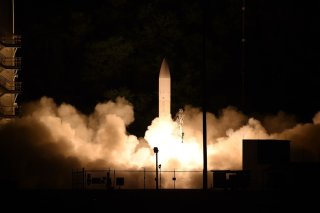Hypersonic Weapons Remain a Priority for Raytheon and Department of Defense
Raytheon has been testing hypersonic weapons designs in a wind tunnel to ensure the missiles are suited for high-speed flight and maneuvering.
The Pentagon is working to fast-track a new generation of hypersonic weapons as part of a deliberate push to close any possible technology gap between the United States, China, and Russia.
Several hypersonic weapons programs are in development, including the Air Force Air-Launched Rapid Response Weapon and the Army’s Long-Range Hypersonic Weapon (LRHW), which is slated to enter service in 2023. Prototyping, test firings, and extensive use of computer simulations and digital engineering have all helped the military accelerate hypersonic weapons. There is already work underway to engineer hypersonic weapons able to hit moving targets as well as fixed targets at long distances.
As opposed to intercontinental ballistic missiles (ICBMs) or long-range ballistic missiles, which travel along a parabolic trajectory and can be seen by satellites and radar systems early in their flight path, hypersonic weapons can fly along a much different trajectory. They are also more maneuverable, making it more difficult to detect or intercept them.
“Hypersonic weapons stay within the upper threshold of the atmosphere and do not have a predictable flight path because of their ability to maneuver, whereas ICBMs leave the atmosphere and fly a predictable trajectory,” said Erin Kocourek, senior director of hypersonic requirements and capabilities at Raytheon Missiles & Defense, in an interview with Raytheon’s website in 2021. “Since hypersonic systems hug the Earth’s atmosphere, they don’t necessarily need to travel as far as ballistic missiles do, so the time to target is less.”
Kocourek said that the Department of Defense and Raytheon have been researching the challenges of hypersonic flight for several years.
“Heat management is one challenge – hypersonic weapons heat up as they accelerate through the atmosphere, so they require airframes that can withstand those blazing temperatures,” she said.
Some of the thermal management challenges associated with hypersonic flight pertain to what Air Force Research Laboratory Scientists call “boundary layer phenomenology.” This refers to the airflow passing a hypersonic weapon moving at high speeds.
Hypersonic projectiles are engineered with precise aerodynamic principles because a turbulent airflow around a hypersonic projective in flight can create instability and change the flight path of the weapon. A smooth airflow helps maintain heat management as well as ensuring the weapon stays on course to destroy its target. Kocourek said Raytheon is working on this by replicating hypersonic flight conditions in wind tunnels.
“Another challenge is understanding the environment our systems will be exposed to during flight,” she said. “We can use wind tunnels to emulate hypersonic flight conditions to a degree, but it’s unclear how well these ground tests accurately capture the shock, vibration and thermal stresses that happen in flight.”
Raytheon scientists then gather vibration data from the wind tunnel in what are known as “freejet tests,” to, as Kocourek put it, “better understand the environment a scramjet creates for the rest of the system."
Kris Osborn is the Defense Editor for the National Interest. Osborn previously served at the Pentagon as a Highly Qualified Expert with the Office of the Assistant Secretary of the Army—Acquisition, Logistics & Technology. Osborn has also worked as an anchor and on-air military specialist at national TV networks. He has appeared as a guest military expert on Fox News, MSNBC, The Military Channel, and The History Channel. He also has a Master's Degree in Comparative Literature from Columbia University.
Image: Wikipedia.

